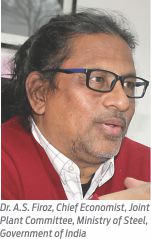The steel industry, like many others, suffers from the problem of excess capacity periodically with demand rising and falling in alternate phases, thus maintaining an overall balance. Steel being among core industries has an inherent growth aspect as it can’t be substituted with another material and its long-term growth prospects are always positive. These views were expressed by Dr. A.S. Firoz, Chief Economist, Joint Plant Committee, Ministry of Steel, Government of India in an interview with Wire and Cable India magazine.
 During the interaction, Dr. Firoz expressed on various market dynamics, apart from demand and supply conditions, which influence the steel pricing. In addition, he spoke in detail on issues of user industry’s grievances with the Government, human resource development and its further requirement, state of steel producing technology in India, etc. Excerpts:
During the interaction, Dr. Firoz expressed on various market dynamics, apart from demand and supply conditions, which influence the steel pricing. In addition, he spoke in detail on issues of user industry’s grievances with the Government, human resource development and its further requirement, state of steel producing technology in India, etc. Excerpts:
Wire & Cable India: To start with, please tell us about the Joint Plant Committee.
A.S. Firoz: The Joint Plant Committee was set up in 1964. Its main functions then used to be regulating production, prices, allocation and distribution of pig iron and steel. The related policies were made after the assessment of market demand and major steel producers were directed to accordingly produce and distribute steel on the determined prices.
However, the role of JPC underwent major transformation after the deregulation of the steel sector in 1991-92 and it ceased to be a policy making and regulating body. After 1992, JPC became a dedicated research body on the iron and steel sector with a function to create and maintain the complete and non-partisan databank on the industry. JPC, therefore, molded itself into a facilitator for industry, focusing only on giving form to a comprehensive databank on production, capacity, export-import, open market prices, producer prices, international prices, etc.. There are many major publications from JPC including occasional survey reports, monthly performance review, bulletins, annual statistics, etc..
JPC’s Economic Research Unit at Delhi, however, is not involved in data collection unlike JPC Kolkata office, which is engaged in data collection and industry liaison. ERU is mainly responsible for analysis of data collected by the JPC and conducts specific studies/analysis entrusted to it by the Ministry of Steel. This is more of policy think tank for the Ministry.
WCI: Being the head of ERU as Chief Economist, do share your current views of the Indian and global steel industry. When do you see demand of steel improving in India, giving a much needed momentum to the steel industry?
ASF: We generally review the steel industry in terms of two parameters, viz. capacity and prices, of course both being closely interrelated. Globally, the steel industry today is facing the problem of excess capacity, not a single steel producing nation being immune to the problem. Collectively, these excess capacities become considerable, often becoming unsustainable and resulting in the need for large-scale capacity closures. Besides, these over-capacities not only locks up investments but also lead to bad-debts and NPAs. The steel industry, like many others, suffers from this problem periodically with demand rising and falling in alternate phases, thus maintaining an overall balance. But, capacity additions being bulky, the balance between demand and capacity additions often lose balance. Steel being among core industries has an inherent growth aspect as it can’t be substituted with another material and its long-term growth prospects are always positive. Moreover, the steel demand varies among various regions. Whereas the demand in developed nations has slackened over time, it is picking up fast in the developing and under-developed economies. Overall, steel consumption base has gone up.
Then, there is the problem of pricing, which is not always a function of demand and supply. Dependent on various other factors, pricing has undergone cyclic fluctuations from time-to-time, sometimes drastically. For example, prices of hot-rolled coil dropped down to a record low at USD 260/tonne, causing a huge concerns for many. The prices of hot-rolled coils today stand at around USD 500 per tonne. This again has been a significant rise and cannot easily be explained by an specific economic factor in the market. The supply-demand scenario in this period did not change tremendously to explain such steep pricing fluctuations. There were other factors responsible for such change as during the period, supply-demand has been somewhat steady. I personally see no reason why prices could plunge to USD 260/tonne or even rise to over USD 500/tonne. These price fluctuations may then be attributed to forces of speculation, larger operation of the spot market, manipulative information flows and the emergence of the futures. Moreover, small development in one steel producing region may have amplified effect on overall market, for example, the market sentiments resulting from the closure of over 120 million/tonnes of induction furnace capacities in China. The closure might have led to a withdrawal for around 50-60 million tonnes of steel from market, which was not a big thing for a gigantic steel producer like China, which could have easily made up for that from the excess capacities elsewhere. But, the sentiment or speculation after closure itself was enough for prices to rise, like it happens in the stock market. We can’t negate a large number of small things happening at a given point of time to produce a magnified outcome, especially in pricing.
Today, we are in good times with demand and pricing both seeing a steady rise. We, however, are in the middle of the demand upswing, which I think would continue for some time if we forget the short-term fluctuations. As far as India is concerned, it is following the global trend being a globally-integrated market and will accrue benefits of improving steel demand and pricing scenario. Steel imports into the country are not much of an issue here. Even if we levy the anti-dumping duty, I don’t see any appreciable benefit for the time being as the steel prices are already too high to receive any significant impact. Moreover, the domestic demand in India was below expectations in the last 2-3 years but I think India is at the doorstep of major demand hike owing to the country’s massive infrastructural need and various government backed projects like ‘Make in India’. Moreover, if a country like India grows at its natural pace, incremental growth itself is big enough to cause significant steel demand rise. Urban development and life style changes are to further boost steel consumption in India in times to come. All put together, we see a definite improvement in the steel demand to a high level. We are just beginning to get a growth rate of 10 percent plus for a sustained period of time.
WCI: When we talk about the steel manufacturers and the forward side of the industry, the steel user industry has the grievance of being ignored in the Govt.’s policy to support the steel industry. Your views on the matter?
ASF: If you look at this kind of vertically integrated lineup, there will always be conflicts – iron ore entities will have a conflict with steel producers, steel producers will have a conflict with the steel user industries, and so on. This is the basic nature of the industrial structure, which you cannot avoid. And, in a free market, these conflicts are stronger. For instance, in a strictly regulated market, you could set iron ore or coking coal prices to set the steel cost at a particular level, and then you can set wire prices or automobile prices. Pricing-control, which can be achieved in a regulated market, is not possible in a free-market scenario.
In a free market situation, market dynamics favors fair play for everyone, much dependent on strengths and weaknesses of the producer. Here, everybody ultimately has a certain capacity to influence prices, be it a buyer or a seller. Most of the free markets are driven by this particular factor of how you are positioned in the market and how weak or strong you are as a buyer or a seller. This is the first thing. Secondly, the government can always come to the rescue where it finds certain anomalous situations or definite distortions in the market. The government can then intervene through its fiscal policy. The government has certain instruments in its hand through which it can stabilize the market. The government’s role is not to control any of the prices but is to create a fair space.
If you look at the steel industry and the user industry, few points have to be noted. The steel industry cannot grow without its user industry. Steel producers have to take the user industry in its fold and have constant discussions with them in regards to product development, market/ business development, prices, etc.. Everything will have to go together and all need to be on the same page. Without that, there cannot be innovations in products or structural change in the industry. It is in the interest of the steel industry that it takes the user industry into its fold. And there are innumerable reasons for it to happen. If it happens, the conflicts will reduce automatically.
Such coming together of steel producer and user industry has happened in the past. For example, around 15 years back, almost the entire auto-grade steel used to be imported, which is not the case now. Today, 85-90 percent of auto-grade steel is produced in India. This is a marked improvement and was possible only after discussing how best the market can be served, benefitting both the steel producer and the user industries. Moreover, such collaborations should be on continuous basis and the user industry can avail the right steel grade for their future products by appraising the steel producers of their requirements in advance as it may take certain time to develop the grade. By the time the product sees the daylight, the required steel grade is also available, cutting short the need to import. This is how it works.
However, when there are persistent grievances and problems faced by the user industry, which is incapable of sorting them out through interactions, they should then approach the Government, which will have to take a balanced view on that matter and take corrective action if posiible within its policy space.
WCI: What are your views on human resource development in the steel industry? Is there any shortage of adequate human capital in the industry as is faced by other industries?
ASF: We are facing shortages of skill in every sectors of the economy. It is the challenge for the steel industry as well. As per a recent study, students after primary and secondary education are not able to answer even very basic concepts and this is grave concern, giving rise to an utmost need to improve the outcome of our primary and secondary education. The scenario is not that bright in higher education as well. Besides, higher education also suffers from the issue of talent retention in the country.
In higher and profession education, timely updation of the curriculum is a big challenge. As a result, the knowledge of professionals in India today does not suit the time and need and they are hardly capable of solving today’s problems. Another study by CII and others says that 85% of India’s engineers are unemployable owing to inefficient training. These are the things, which affect the economy at all levels, not just the steel industry.
Besides, the steel industry itself has not been able to attract and retain the bright people. It is true in a sense that steel industry’s workplace is not as comfortable as the workplace of a finance executive sitting in a metropolitan city. The job condition may be comparatively challenging and remunerations not at par with other lucrative sectors.
WCI: India today is the third largest steel producer in the world and the industry has come a long way from its inception. How has the journey been on the front of adapting to various technological advancements in the steel production?
ASF: Like steel, technology is also a globally treated product. You don’t need to develop a technology if it is readily available off-the-shelf. Key technologies for the steel industry are available and well-known. Globally, there are steel giants, who have already setup huge capacities, infrastructure, and even have merged together to actually economized on it. It is not that we require billions of dollars to set up fresh R&D. We don’t need to start everything from scratch. That is not the whole idea. We start from where they have left. We will do the incremental part and to take some time out for R&D in the process.
WCI: Would you like to add anything else to this interaction?
ASF: The steel industry is a very interesting industry. So often, it faces strong challenges and we talk about survival in most of the time. From technology to finance to production, it is a fascinating and dynamic industry. The new challenges are coming up every day, and we are assured of strong growth for the sector. We have to be here amidst these challenges and do everything best that we can to prosper and grow.




